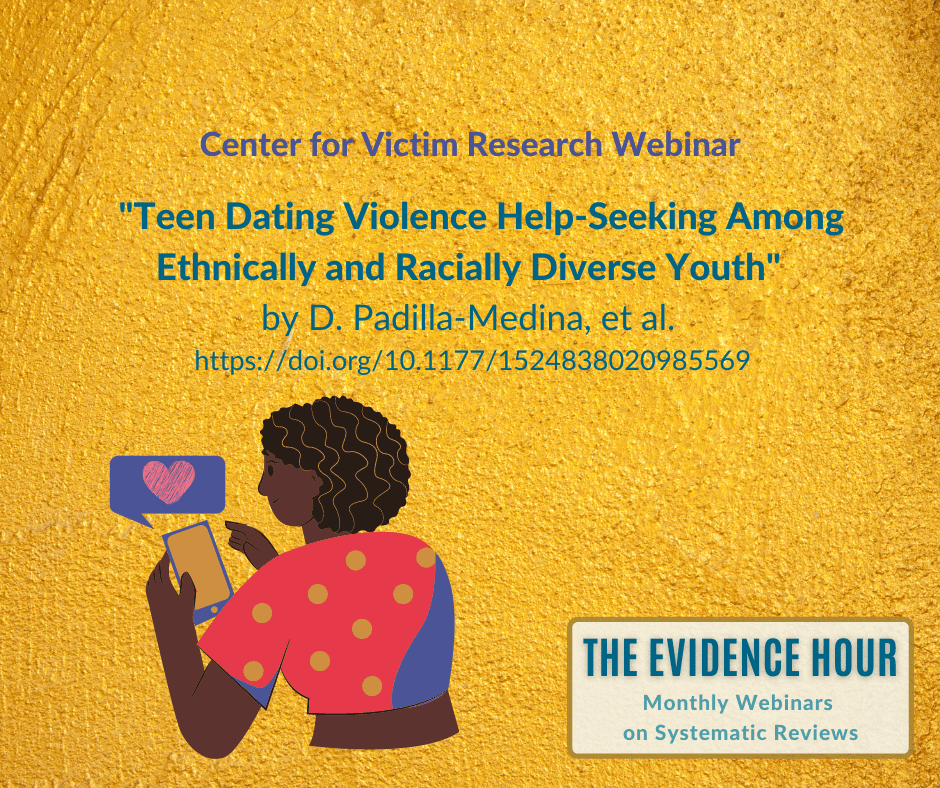The Evidence Hour: Teen Dating Violence Help-Seeking Among Ethnically and Racially Diverse Youth

Center for Victim Research’s webinar series, The Evidence Hour, showcases a recent systematic review* or meta-analysis about victimization, trauma, or victim services. Each webinar features an author of the research and a practitioner discussant who will review the findings and reflect on what they mean for victim service providers and researchers.
On May 20 from 1:30pm-2:30pm ET, we discussed the article: “Teen Dating Violence Help-Seeking Intentions and Behaviors Among Ethnically and Racially Diverse Youth: A Systematic Review” by Diana Padilla-Medina et al. (2021) in Trauma, Violence, & Abuse. [Email the Center for Victim Research Librarian for article access]. The recording is available on our YouTube channel.
Related Research on Teen Dating Violence and Help-seeking:
- Who, When, How, and Why Bystanders Intervene in Physical and Psychological Teen Dating Violence (Abstract) by K. Debnam & V. Mauer (2021). Trauma, violence, & abuse. This scoping review summarizes research on what increases the likelihood that a teen will intervene in TDV situations. Adolescents most likely to get involved had an existing relationship with victims and believed they had a responsibility to step in and that their actions could make a difference. School climate and trusting relationships between students and teachers were important for students to feel confident in intervening to end dating violence. [Contact the Librarian for full-text access]
- Forcible Rape and Adolescent Friendship Networks (Abstract) by T.A. Tomlinson et al. & Postincident Interpersonal Difficulty Among Adolescent Victims of Violent Crime (Abstract) by J.B. Phillips (2021) in Journal of interpersonal violence. These two articles analyze how experiencing victimization effects survivors’ perceptions of their relationships with friends and families. Trauma, physical injuries, and responses to disclosure can act as barriers to social support, which is often an important component of many survivors’ coping and healing. The researchers suggest what victims and victims’ loved ones can do to counteract this impact. [Contact the Librarian for access]
- The Impact of Culturally Relevant Programs by Joan Dominguez. (2019). Center for Victim Research. This annotated bibliography emphasizes the importance of centering survivors’ complex, dynamic identities as they heal from violent experiences.
Related Resources from our Research2Practice Network:
- National Indigenous Women’s Resource Center Special Collection: For Native Teens
- National Sexual Violence Resource Center: Teen Dating Violence Prevention – 2021 Update and podcast episode on “What is an Askable Adult?”
- VAWnet Special Collection: Preventing & Responding to Teen Dating Violence
*What are Systematic Reviews?
- A systematic review is the process of bringing together all available studies about a well-defined question, analyzing the quality of their study methods, and summarizing their findings.
- Systematic reviews often use a statistical practice called meta-analysis. This means combining data from multiple studies, to calculate the average effect of the intervention and find patterns.
- Because systematic reviews pool results from many experiments and rate the methods of each study, these reviews increase our confidence in the quality and consistency of the evidence and what it means for the field.
Basically, systematic reviews take a large amount of information about a complex issue from multiple sources and make that information more manageable and usable. These reviews can also help make sense of conflicting findings from different studies.
Learn more from:
- Quick Reference: Systematic Reviews
- Quick Reference: Tips on Reading Research Articles
« PREVIOUS NEXT »

Leave a Reply
You must be logged in to post a comment.